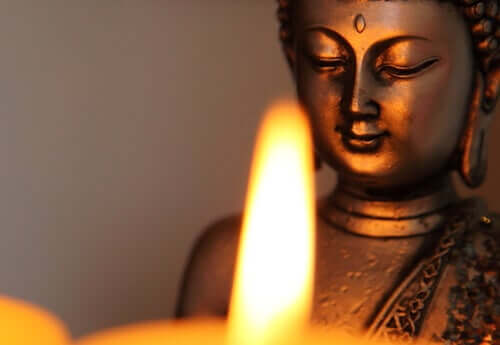The Heart Sutra is a very popular text of the Buddhist school of thought, considered the most studied and sought after of all Buddhist texts, and attracts many followers of this philosophy for its brevity and for being considered a collection of wisdom.
It is very interesting that such a brief text has been the subject of so much research by Buddhists and that it is identified as one of the lifelong teachings that must truly be understood. The Heart Sutra contains only 14 verses, originally written in Sanskrit. what is considered one of the most powerful mantras of Buddhism.
- The Heart Sutra dates back to the 1st century.
- Although some think it may be even older.
- He speaks of many of the central concepts of Buddhism.
- Such as emptiness.
- Detachment.
- Compassion.
- Form.
- Will.
- And conscience.
“All evil deeds come from the mind. If the mind changes, how can these acts remain?-Bouddha-
Almost the entire Heart Sutra focuses on the concept of emptiness. However, this void has a different meaning of “nothing,” as Westerners understand it.
Emptiness is not the same as absence or lack, because the emptiness of what or of those who are not present is filled with this absence, the same goes for the concept of deprivation: it is not empty, but filled with this imaginary presence of what it is. Disappeared.
When Buddhists talk about empety they refer to the idea that nothing that exists has an intrinsic reality, that is, everything constantly changes and changes, that is, being and letting it be, what we perceive with our senses is just the appearance of things. That’s why we believe that reality is “full,” even if it isn’t.
Emptiness is linked to the constant mutability of all that exists, nothing ceases or differs completely from others, nor is it pure or unclean, complete or deficient.
What really exists are mental formations that lead us to see reality as we perceive it, however, these mental workouts are not reality, reality is independent and changes all the time, without even realizing it.
Contrary to what some people think, mantras are not magic words to attract luck or achieve certain goals, in Buddhism they are a way to reach certain levels of meditation, their role is to contribute to the awakening of consciousness.
The mantra at the end of the Heart Sutra is: Gate gate P?Ragate P? Rasa? Door?Bodhi sv? H?.
It’s in Sanskrit and its translation would be: “Go, go, go up, go for the greatest awakening. Will this be the case!?. Some translated it as follows: “It was, it went, it went further. Completely exposed, stripped. Wake up Hello!
Those who understand the subject point out that the Sanskrit word Door refers precisely to empty, but to a personal level. This equates to the concept of “not me. ” What goes or goes is the ‘I’.
Mantra is therefore a call to separate you, which is considered a source of misunderstanding and suffering. The “I” in this case is synonymous with ego. What we’re looking for is for the ego to dissipate so that emptiness emerges.
Although the Heart Sutra is a text of great complexity, what it finally shows is the way to achieve it or “hello”. It consists of abandoning the ego to find the void and thus gain a deep perception and understanding of reality.
That is, the one who is guided by his eyes, ears and hands, as well as by his mind, is destined not to know or understand reality. Likewise, those who manage to free themselves from the senses and the very way of thinking of their minds are able to merge with reality and understand it, not as an intellectual act, but in terms of transcendent experience.
Awakening is precisely the state in which we stop perceiving the world by limited means, such as our senses and our own minds. Enlightenment comes down to a complete understanding that, for Buddhists, brings two great virtues: detachment and compassion.

